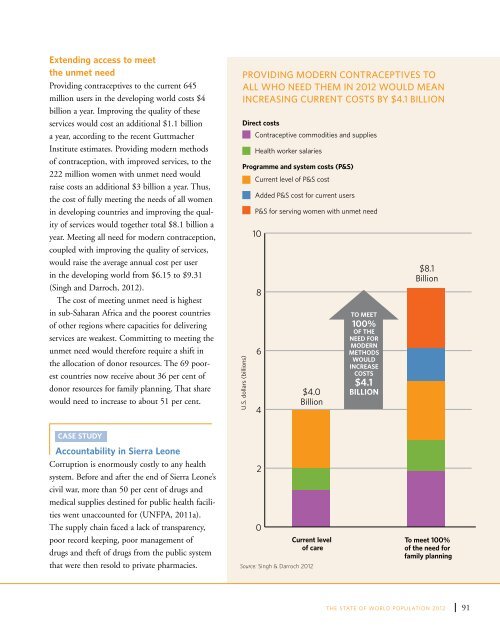State of World Population 2012 - Country Page List - UNFPA
State of World Population 2012 - Country Page List - UNFPA
State of World Population 2012 - Country Page List - UNFPA
Create successful ePaper yourself
Turn your PDF publications into a flip-book with our unique Google optimized e-Paper software.
Extending access to meet<br />
the unmet need<br />
Providing contraceptives to the current 645<br />
million users in the developing world costs $4<br />
billion a year. Improving the quality <strong>of</strong> these<br />
services would cost an additional $1.1 billion<br />
a year, according to the recent Guttmacher<br />
Institute estimates. Providing modern methods<br />
<strong>of</strong> contraception, with improved services, to the<br />
222 million women with unmet need would<br />
raise costs an additional $3 billion a year. Thus,<br />
the cost <strong>of</strong> fully meeting the needs <strong>of</strong> all women<br />
in developing countries and improving the quality<br />
<strong>of</strong> services would together total $8.1 billion a<br />
year. Meeting all need for modern contraception,<br />
coupled with improving the quality <strong>of</strong> services,<br />
would raise the average annual cost per user<br />
in the developing world from $6.15 to $9.31<br />
(Singh and Darroch, <strong>2012</strong>).<br />
The cost <strong>of</strong> meeting unmet need is highest<br />
in sub-Saharan Africa and the poorest countries<br />
<strong>of</strong> other regions where capacities for delivering<br />
services are weakest. Committing to meeting the<br />
unmet need would therefore require a shift in<br />
the allocation <strong>of</strong> donor resources. The 69 poorest<br />
countries now receive about 36 per cent <strong>of</strong><br />
donor resources for family planning. That share<br />
would need to increase to about 51 per cent.<br />
Providing modern contraceptives to<br />
all who need them in <strong>2012</strong>would mean<br />
increasing current costs by $4.1 billion<br />
Direct costs<br />
Contraceptive commodities and supplies<br />
Health worker salaries<br />
Programme and system costs (P&S)<br />
U.S. dollars (billions)<br />
Current level <strong>of</strong> P&S cost<br />
Added P&S cost for current users<br />
P&S for serving women with unmet need<br />
10<br />
8<br />
6<br />
4<br />
$4.0<br />
Billion<br />
TO MEET<br />
100%<br />
OF THE<br />
NEED FOR<br />
MODERN<br />
METHODS<br />
WOULD<br />
INCREASE<br />
COSTS<br />
$4.1<br />
BILLION<br />
$8.1<br />
Billion<br />
CASE STUDY<br />
Accountability in Sierra Leone<br />
Corruption is enormously costly to any health<br />
system. Before and after the end <strong>of</strong> Sierra Leone’s<br />
civil war, more than 50 per cent <strong>of</strong> drugs and<br />
medical supplies destined for public health facilities<br />
went unaccounted for (<strong>UNFPA</strong>, 2011a).<br />
The supply chain faced a lack <strong>of</strong> transparency,<br />
poor record keeping, poor management <strong>of</strong><br />
drugs and theft <strong>of</strong> drugs from the public system<br />
that were then resold to private pharmacies.<br />
2<br />
0<br />
Current level<br />
<strong>of</strong> care<br />
Source: Singh & Darroch <strong>2012</strong><br />
To meet 100%<br />
<strong>of</strong> the need for<br />
family planning<br />
THE STATE OF WORLD POPULATION <strong>2012</strong><br />
91
















